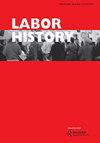父权社会中的性别移民:战后早期希腊的女性移民援助
IF 0.7
4区 管理学
Q1 HISTORY
引用次数: 0
摘要
摘要1954年,欧洲移民政府间委员会(ICEM)启动了一项计划,从希腊为加拿大、澳大利亚和新西兰招聘家政工人。ICEM为农村背景、资源匮乏的单身妇女提供了移民的机会,并在以后资助其亲属的移民。此外,ICEM还为他们提供定向和语言课程、培训计划和贷款,并监督他们的交通和招聘,以及他们对经济和“文化”发达国家的工作和生活的适应。在这样做的过程中,委员会试图向来自“自由世界”外围的妇女灌输“优越”的西方技术技能、文化价值观和现代行为模式,这些技能、价值观和模式再现了目的地国家的主导性别、种族、种族和阶级偏见。这篇文章强调了接收国如何通过标准化外国女性劳动力的技能、行为和权利,扩大其控制边境和选择外国女性劳动力“素质”的能力。通过比较该计划在三个英联邦国家的实施情况,它质疑了国际组织在劳动力模式构建和霸权西方性别经济、社会和文化脚本在欧洲周边国家传播中的作用。它还探讨了国际移徙委员会在家务劳动和妇女对政府间移徙规划的反应方面带来的变化。本文章由计算机程序翻译,如有差异,请以英文原文为准。
Gendering migration in a patriarchal society: assisted female migration from Greece during the early post-war period
ABSTRACT In 1954 the Intergovernmental Committee for European Migration (ICEM) launched a program for the recruitment of domestic workers from Greece for Canada, Australia and New Zealand. ICEM gave single women of rural background and with scarce resources the opportunity to migrate and later sponsor the migration of their relatives. Furthermore, ICEM assisted them with orientation and language courses, training programs and loans, and oversaw their transportation and recruitment, as well as of their adjustment to work and life in economically and “culturally” developed countries. In doing so, the Committee tried to imbue women from the periphery of the “Free World” with “superior” western technical skills, cultural values and modern behavioral patterns that reproduced the dominant gender, ethnic, race and class prejudices of the destination countries. The article highlights the way receiving states expanded their capacity to control their borders and select the “qualities” of their foreign female workforce, by standardizing their skills, behaviors and rights. By comparing the implementation of the scheme in three British Commonwealth countries, it problematizes the role of the international organizations in the construction of labor patterns and the dissemination of hegemonic Western gendered economic, social and cultural scripts in a peripheral European country. It also explores the changes brought about by the ICEM in domestic work and women’s response to intergovernmental migration planning.
求助全文
通过发布文献求助,成功后即可免费获取论文全文。
去求助
来源期刊

Labor History
Multiple-
CiteScore
1.00
自引率
28.60%
发文量
44
期刊介绍:
Labor History is the pre-eminent journal for historical scholarship on labor. It is thoroughly ecumenical in its approach and showcases the work of labor historians, industrial relations scholars, labor economists, political scientists, sociologists, social movement theorists, business scholars and all others who write about labor issues. Labor History is also committed to geographical and chronological breadth. It publishes work on labor in the US and all other areas of the world. It is concerned with questions of labor in every time period, from the eighteenth century to contemporary events. Labor History provides a forum for all labor scholars, thus helping to bind together a large but fragmented area of study. By embracing all disciplines, time frames and locales, Labor History is the flagship journal of the entire field. All research articles published in the journal have undergone rigorous peer review, based on initial editor screening and refereeing by at least two anonymous referees.
 求助内容:
求助内容: 应助结果提醒方式:
应助结果提醒方式:


